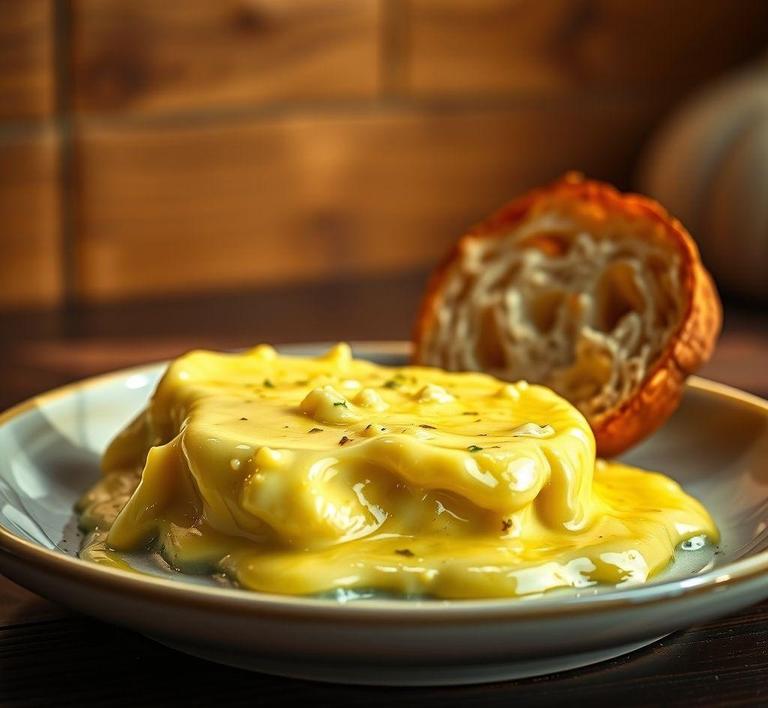If you’ve ever found yourself with extra garlic butter after cooking up a delicious meal, you might be wondering, ‘Can I refreeze this and still keep that rich, savory flavor?’ Well, you’re in the right place! Refreezing garlic butter is not only possible, but it can be a great way to make sure none of that garlicky goodness goes to waste. In this guide, we’ll walk you through the best methods for refreezing garlic butter so that it maintains its smooth texture and bold taste. Get ready to store your leftovers like a pro!
Can You Refreeze Garlic Butter?

Yes, you can refreeze garlic butter-but with caveats. The primary concern isn’t safety (assuming proper food handling), but rather the quality of the butter once it’s been frozen, thawed, and then frozen again. Garlic butter is a compound butter-typically made from softened butter blended with minced garlic, herbs like parsley, and sometimes a dash of lemon juice or salt. These ingredients each respond differently to freezing and thawing cycles.
Butter, with its high fat content, freezes quite well. Garlic, however, is a bit trickier. Once thawed, it can become slightly rubbery or develop a stronger, sometimes slightly bitter flavor due to enzymatic changes. If the garlic butter was homemade or purchased fresh, and has been thawed in the refrigerator (never left out at room temperature), it’s generally safe to refreeze.
The key determinant is how the butter was stored and for how long. If the garlic butter was thawed for more than 48 hours in the fridge or if it ever sat at room temperature for more than 2 hours, it’s best to avoid refreezing. In these cases, bacterial growth becomes a potential concern, and even freezing won’t undo that.
How To Refreeze Garlic Butter?
Refreezing garlic butter correctly involves careful handling to minimize moisture loss, flavor degradation, and contamination. Here’s how to do it:
-
Assess Freshness and Temperature:
Before refreezing, ensure that the garlic butter is still within its safe shelf life. If it’s been refrigerated and still smells and looks fresh, you’re good to go. Never refreeze if it has a sour odor, discoloration, or slimy texture.
-
Portion Wisely:
Divide the butter into smaller, usable portions before freezing. This minimizes the need to thaw and refreeze large quantities multiple times. Use silicone ice cube trays, small airtight containers, or wrap tablespoon-sized portions in plastic wrap or parchment paper.
-
Use an Airtight Method:
Oxygen exposure contributes to freezer burn and rancidity. Place the garlic butter portions in a heavy-duty freezer bag or vacuum-seal them. If using containers, choose ones with tight-sealing lids and minimal headspace.
-
Label and Date:
Always label your packages with the refreeze date. This helps you keep track of freshness. Ideally, use refrozen garlic butter within 1-2 months for best quality.
-
Freeze Quickly:
A fast freeze helps preserve the butter’s texture and flavor. Place the butter portions at the back of your freezer, where temperatures remain consistently cold.
Quality Impact
While safe, refreezing garlic butter does come with some trade-offs in texture and taste. The most noticeable changes include:
-
Texture Degradation:
After the second freeze, the butter may become slightly grainy or lose some of its creamy mouthfeel. This is due to the fat and water content separating during freeze-thaw cycles. It’s less noticeable if you’re using the butter in cooking or as a spread on warm foods.
-
Garlic Flavor Changes:
Garlic can intensify or even sour slightly upon repeated freezing and thawing. This may lead to a more pungent or off-putting aftertaste in delicate dishes like garlic bread, sauces, or compound butters used as finishing touches.
-
Herb Wilting:
If your garlic butter includes fresh herbs like parsley or chives, they may darken or become limp after refreezing, losing their bright, fresh appearance and flavor.
-
Aroma Loss:
Aromatic compounds-especially in garlic and herbs-tend to dissipate over time in the freezer. Refreezing accelerates this effect. Your garlic butter might smell slightly muted compared to a freshly made batch.
Despite these quality issues, refrozen garlic butter still works well in cooked applications. Stir it into mashed potatoes, melt it over grilled meats, or use it in pasta sauces, where slight changes in texture and flavor are less detectable.
Refreezing garlic butter is certainly possible-and often practical-if done carefully and sparingly. Safety isn’t the issue as much as quality, and being mindful of how long the butter has been thawed and how it was stored makes all the difference. The flavor of garlic may intensify or deteriorate slightly, and texture changes might occur, especially with repeated refreezing.
Ultimately, if you anticipate needing garlic butter in small amounts over time, the best approach is to portion and freeze it properly from the start. That way, you avoid the need to refreeze altogether and preserve its rich, aromatic profile for whenever inspiration strikes in your kitchen.
Is It Safe To Refreeze Garlic Butter?
Garlic butter-a savory fusion of creamy dairy richness and aromatic allium-is a staple in many kitchens. Whether slathered over bread, melted onto steak, or folded into pasta, it brings flavor and flair to any dish. But what happens when you’ve defrosted a batch and didn’t use it all? Can you safely refreeze it?
The short answer is: yes, it is generally safe to refreeze garlic butter, but with a few important caveats.
Garlic butter consists primarily of butter (a high-fat dairy product) and garlic, sometimes with added herbs or oils. The safety of refreezing depends largely on how the butter was handled after defrosting. If it was thawed in the refrigerator and remained below 40°F (4°C) throughout, then it is typically safe to refreeze, albeit with some potential compromises in texture and flavor. However, if the butter was thawed at room temperature, or worse, microwaved and partially melted, refreezing could encourage bacterial growth, spoilage, and possible foodborne illness.
Butter is relatively forgiving when it comes to freezing, but garlic and herbs may not be. Their cell structure breaks down during freezing and thawing, which can cause textural changes and a slightly altered taste-especially if the butter is refrozen multiple times. In particular, raw garlic contains moisture, which, once frozen and thawed again, can become mushy and lose its pungency.
In summary, while refreezing garlic butter is not inherently dangerous if done under safe conditions, it is not ideal from a quality perspective. Proper storage and defrosting practices are essential to ensure safety and preserve taste.
Signs That Garlic Butter Should Not Be Refrozen
Before reaching for that container of garlic butter to stick it back in the freezer, it’s critical to assess whether it’s still good. Here are some clear signs that your garlic butter should be discarded rather than refrozen:
-
Sour or Off Smell:
Garlic butter should smell rich, creamy, and pungently garlicky. If you detect a sour, rancid, or ‘off’ odor-similar to spoiled milk or cheese-that’s a strong indicator of bacterial growth or spoilage.
-
Discoloration:
Fresh garlic butter typically has a uniform pale yellow color. If you notice dark spots, a grayish tinge, or green patches (a potential sign of mold), it’s no longer safe to use.
-
Texture Changes:
Butter that has developed a grainy, slimy, or curdled texture after thawing may be on the path to spoilage. This is often caused by improper thawing or temperature abuse during storage.
-
Mold Growth:
Mold can appear as fuzzy patches in white, green, or black. Even if the mold is only on the surface, it’s best to discard the entire batch. Mold spores can infiltrate soft or semi-soft spreads like garlic butter, making it unsafe to simply scrape off the visible portion.
-
Time at Room Temperature:
If the garlic butter was left out at room temperature for more than two hours, particularly in warm weather, bacteria such as Listeria or Staphylococcus aureus may have had a chance to proliferate. Refreezing at this point could trap those bacteria in a dormant but dangerous state.
Common Refreezing Mistakes
Many people assume that as long as food is put back in the freezer, it’s safe. Unfortunately, that’s not always true. Here are some of the most common mistakes people make when trying to refreeze garlic butter:
-
Refreezing After Counter Thawing:
Thawing butter on the counter is a tempting shortcut, but it’s also one of the most unsafe. Leaving butter at room temperature allows bacteria to multiply rapidly. Refreezing at this stage doesn’t kill bacteria; it just slows them down.
-
Repeated Freezing and Thawing:
Constantly thawing and refreezing garlic butter breaks down both its flavor and structural integrity. This leads to separation (the butterfat and milk solids splitting), watery texture, and flavor loss.
-
Not Using Airtight Containers:
When garlic butter is improperly sealed before freezing or refreezing, it becomes vulnerable to freezer burn. This not only affects taste and texture but also encourages oxidation and off-flavors, particularly in garlic and herbs.
-
Ignoring Time Limits:
Even in the freezer, garlic butter has a shelf life. Refreezing something that’s been sitting in the fridge for too long (more than a week) risks reintroducing bacteria into your freezer. Always keep track of storage dates and label your containers.
Tips And Tricks
To ensure the best quality and safety when handling garlic butter, follow these expert tips and culinary tricks:
-
Freeze in Portions:
Divide garlic butter into small, usable portions (like tablespoon-sized scoops or in ice cube trays). This prevents the need to thaw a large batch and refreeze leftovers.
-
Use a Vacuum Sealer or Airtight Wrap:
Prevent exposure to air by sealing garlic butter tightly with plastic wrap, foil, or a vacuum-sealed bag. This preserves freshness and prevents absorption of odors from other freezer items.
-
Label with Date:
Always date your containers before freezing. Garlic butter can safely remain frozen for about 3-6 months, but flavor is best if used within the first 2 months.
-
Thaw in the Refrigerator:
Always thaw garlic butter in the fridge, never on the countertop. Slow refrigeration defrosting keeps the temperature stable and prevents the growth of harmful bacteria.
-
Consider Compound Butter Logs:
Roll garlic butter into logs using parchment paper or plastic wrap. Slice off what you need when cooking. This avoids the need to thaw or refreeze altogether.
-
Try Herb-Free Batches:
If you plan to freeze and potentially refreeze often, consider making batches with just garlic and butter. Add fresh herbs later during cooking to preserve the vibrancy and freshness of flavor.
Conclusion
Garlic butter is a culinary treasure, and while it can be refrozen under the right conditions, doing so requires careful attention to detail. Food safety should always be your guiding star-only refreeze garlic butter that has been thawed in the refrigerator, shows no signs of spoilage, and hasn’t been exposed to unsafe temperatures.
Though refreezing may slightly compromise texture or flavor, proper storage, portion control, and cautious handling can minimize these effects. Avoiding common mistakes and following expert tips can help you preserve your garlic butter’s integrity and savor its flavor for months to come.
In the end, when in doubt, it’s always better to err on the side of caution. No garlic-laced indulgence is worth a brush with foodborne illness. Happy cooking-and may your garlic butter always be rich, aromatic, and safe to enjoy!

